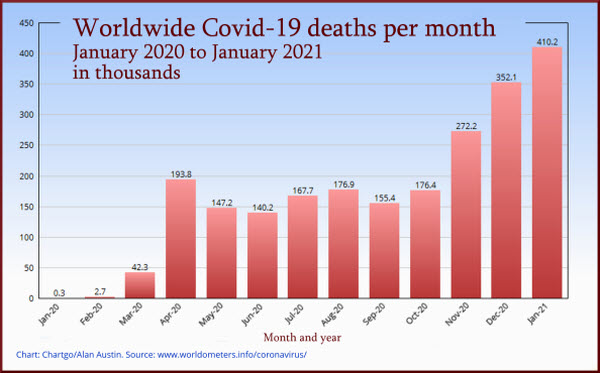
COVID-19 deaths around the world have steadily increased, despite lockdowns and medical advances. May and June last year experienced promising declines, as did September. But November was bad, December worse and January worst of all, with a death toll of more than 410,000 people.

COVID-conquering countries
Clearly some countries have met the challenge much better than others, which confirms ever-increasing fatalities are not inevitable. Appropriate strategies do work.
Globally, 22 major countries had no deaths in January — up from 19 in December, but down from 23 in November. The developed countries in this list are Australia, New Zealand, Iceland and Singapore. This is a welcome return to the winners’ circle for Australia after one death in each of the last two months.
New Zealand leads the developed world with no deaths since September 16. Taiwan ended an impressive run of seven fatality-free months with one death in late January. And after almost an entire unblemished year, Mongolia reported its first death in December and a second in January.
Mainland China recorded two deaths in January after seven months with none, but there are some doubts about the accuracy of its data.
Methodology
This analysis examines all 176 major nations — populations over 300,000 — which have their coronavirus data tabulated by Worldometers. As Crikey has published previously, care must be taken with data from poor African nations and repressive regimes.
Western Sahara and Tanzania — with a combined population of 61 million — have recorded no new cases and no deaths since May. Maybe. Maybe not. There is no data from North Korea or Turkmenistan.
Countries showing substantial improvement
This series accepts the benchmark for success in controlling the pandemic as having deaths below three per million per month. On this measure, the number of successful nations fell through 2020.
In September, 81 countries lost fewer than three citizens per million. This slipped to 72 in October, then 68 in November, 59 in December and 57 in January.
Saudi Arabia shows an impressive recent trajectory with 1031 deaths in August, 634 in October, 327 in December and 152 in January.
Qatar, similarly, had recorded 232 deaths by the end of October, an average of about 26 a month. This fell to five in November, rose to eight in December and fell back to three in January.
Unfortunately no country in mainland Europe or the Americas made significant progress in January. Bolivia’s remarkable performance — from 2965 deaths in September to 784 in October and 197 in December — came to a screeching halt with a surge to 1181 deaths in January.
Disastrous declines
In January, 22 countries had more than 200 deaths per million, down from 27 in December. Perhaps that offers a glimmer of hope.
The 20 countries with the worst rates were Lebanon, the United States, Panama and Mexico, two African states and 14 European states. This is a broader geographic region than last month, when the worst-hit 20 were 19 European nations and the US.

Portugal suffered most with 5576 deaths at 548 per million, then Lithuania with 1345 deaths at 498 per million and the United Kingdom with 32,646 deaths at 480.
Portugal’s plight has been palpable. From just 87 deaths in August, it exploded to 536 in October, to 2401 in December and 5576 in January.
The UK has fared even worse. From 302 deaths in August, it jumped to 4412 in October, 15,064 in December and an appalling 32,646 in January.
Thailand and Hong Kong have lost their status as nations with zero monthly deaths, recording 16 and 33 respectively in January.
US continues to lag
The US recorded 97,899 deaths in January at 295 per million, by far its worst month. December’s deaths were 80,097, up from 24,134 in September.
Although it has just 4.25% of the world’s population it has 20.2% of the world’s total deaths, 25.9% of all cases since the onset a year ago and, disturbingly, 38% of all current active cases. It recorded 23.9% of all January deaths.
There are great hopes that the vaccine rollout will bring these numbers down sharply. February’s facts and figures will be informative. Fingers crossed.








“This is a welcome return to the winners’ circle”
says Alan Austin above, discussing Australia’s covid response compared to other nations. Elsewhere in Crikey today Luke Slawomirski says
“This isn’t the Olympic Games. It’s a deadly pandemic that needs to be stopped as soon as possible.”
Maybe the two should talk to each other. I’m hoping AA accepts LS’s view.
Yes, a little cavalier in his language. It is neither the olympics or a horse race.
Probably should be ‘nor’ but I’m sure you get my drift.
It could be of interest and possibly useful to show the relationship between measures taken, infections and death rates.
The latter is a significant variable as many nations have ageing populations e.g. southern (Italy after Japan) and central Europe with broader health systems (not just ICU beds), with sub-optimal resources.
Conversely, one imagines Japan, another ageing nation, has done significantly better than its European counterparts?
It’s appalling to see USA, Germany and the UK in the worst 20 countries. Total mismagement by let the economy run free, dumb club of Johnson and Trump.
As for Merkel, was it a combination of citizen opposition and lack of political strength / will?
If the first measure of government is protection of its citizens, they have failed miserably.